
China primes pesticides for armyworm emergency
- Officials lists 25 products and call on authorities to guide farmers in their use
- Pest has been found on at least 92,000 hectares of farmland
China has recommended the use of pesticides against fall armyworms, as the insect spreads across the country’s farmlands, the agriculture ministry said on Wednesday.
Armyworms have been reported in 18 of China’s provinces, regions and municipalities since it was first detected in southwestern Yunnan province in January, a statement on the ministry’s website said.
The fall armyworm “severely threatens the agriculture and grain production security of China”, it said.
China has recommended 25 pesticides for emergency use, and has asked local authorities to guide farmers in the use of these products, which include the insecticides chlorfenapyr and acephate.

The emergency use of these pesticides to combat armyworms would last until the end of next year, the ministry said.
Fall armyworms, which feast in large numbers on the leaves and stems of many plant species – including sorghum, corn and sugar cane – can infest and damage hundreds of hectares of crops overnight. The pest was expected to reach the country’s northeastern corn belt by this month or July, an analyst with a government think tank said.
Armyworm to bite China’s under pressure food supply within two months as trade war tariffs limit US crop imports
The pest has been found in at least 92,000 hectares (227,340 acres) of farmland in China, mostly in corn and some sugar cane crops.
China had about 130 million hectares of arable land as of the end of 2017 and grows corn on about 42 million hectares. Sugar cane covered 1.24 million hectares in the year 2018-19.

